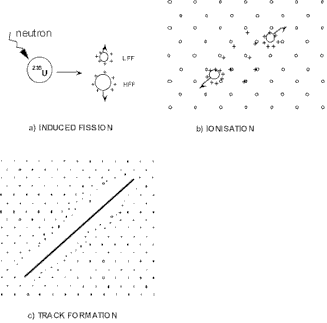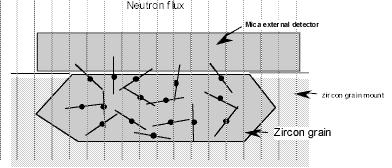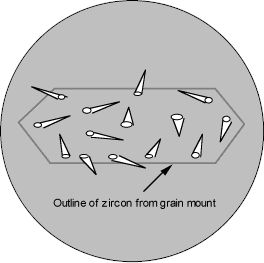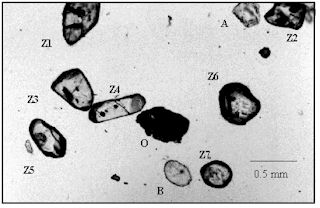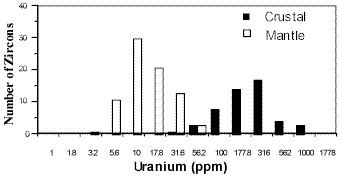 |
 |
 |
 |
 |
 |
||
 |
|||||||
Uranium in mineral sands: measurement and uses
I.R. Duddy and P.R. Kelly
Australian Institute of Geoscientists Bulletin No. 26 1999Introduction
The uranium content of minerals such as zircon and rutile is a key parameter in the economics of mineral sand production as high uranium contents may significantly down grade the value of the mineral sand product. In this short paper the application of fission track methods to the highly accurate determination of uranium in individual mineral grains (eg Lovering & Kleeman 1970) is described and discussed. In the early exploration phase, the technique allows the rapid identification of the minerals hosting uranium and the determination of the absolute U-content in individual grains. In the development and production phase, use of the single grain technique permits the development of strategies for adjusting mineral processing procedures to separate desirable low-uranium mineral populations. The paper will also briefly address more general uses of the fission track method in provenance studies for heavy minerals, diamond exploration and geochronology.
Basics of the fission track method for Uranium determination
Uranium is a common trace constituent of many heavy minerals. Apart from uranium minerals sensu stricto, monazite and zircon are typically the main uranium hosts in mineral sand deposits, containing around 100 to 1000 ppm. Rutile and apatite typically contain between 10 and 100 ppm U, but higher amounts occur.
Uranium decays spontaneously by two main processes: Alpha decay and fission decay. In this application we are only concerned with fission decay. Natural spontaneous fission occurs only for the most abundant uranium isotope, 238U (~99% of natural uranium). The second most abundant Uranium isotope, 235U (~0.7% of natural uranium), does not undergo natural fission but it may be artificially induced to fission by bombardment with thermal neutrons. The ability of 235U to undergo induced fission provides the basis for the quantitative determination of uranium content in mineral grains discussed here.
The process of induced fission is illustrated in Figure 1. Collision of a thermal neutron with 235U causes the atom to split into two sub-equal fragments that have very high positive charges. These fragments move apart damaging the crystal lattice of the host mineral by an ionisation process, essentially the removal of electrons from the lattice atoms. With the passage of the fission fragments through the lattice, the now positively charged lattice atoms repel each other, forming a disrupted zone in the crystal. This disrupted, glass-like, zone is known as a fission track. In zircon, these tracks are approximately 50 angstroms wide and 12 µm long whereas in apatite they are around 16 µm long and in mica around 20 µm long.
The key aspect of the exploitation of this process is that the number of induced fission tracks is directly proportional to the uranium content of the mineral host.
Figure 1: Formation of induced fission tracks in a crystal lattice.
A. Bombardment of 235U with thermal neutrons causes fission.
B. The highly positive charged 235U fission fragments fly apart, ionising the crystal lattice, essentially by removing electrons.
C. The remaining positively charged lattice atoms repel each other causing a damaged zone in the crystal - the fission track. In zircon, the damage zone is ~12 µm long and 50 Å wide.
Uranium determination in individual mineral grains by the external detector method
Uranium content (U) can be measured by irradiating the mineral sample with a calibrated dose of thermal neutrons and measuring the number of tracks produced by induced fission of 235U per unit area of the apatite grain surface (the "induced track density", rhoi).
U unknown = rhoi unknown x U std / rhoi std
rhoi is measured in a muscovite "external detector" attached to the surface of the unknown and standard.
Induced fission tracks leave the grain and form tracks in the mica external detector, which is subsequently etched (in hydrofluoric acid) so that rhoi can be measured using an optical microscope. The procedure is illustrated in Figure 2.
In practice, the mineral grains for U-determination are mounted as a strewn mount on a glass slide in epoxy resin and polished as for a rock thin section. A mica external detector is placed over the grain mount and held in place with a heat shrink plastic. Groups of grain mounts are stacked together with U-bearing calibration standard glasses with attached mica detectors, at each end. The complete package is then subjected to irradiation with thermal neutrons after which the detectors from the samples and standards are removed and etched and the number of tracks counted.
Figure 2A: Mica external detector held against mineral grain mount during irradiation with thermal neutrons (view in section). Fission tracks are induced throughout the body of the crystal as shown but only those within range of the surface (~12 µm) leave the crystal and a recorded on the mica external detector.
Figure 2B: Mica external detector removed from grain mount and etched to reveal induced fission tracks from the zircon grain (view in section).
Figure 2C: Microscope plan view of mica external detector showing etched tracks from the fission of uranium in the zircon grain that was in contact during irradiation. The number of tracks in a given area is directly proportional to the uranium content.
Uranium in mineral sands - know where the uranium is early in a project
With the ability to determine the U-content of individual grains, comes the ability to closely monitor the fate of Uranium in mineral processing. For example, there may be a tendency for grains of a particular grain size to have unacceptably high U contents. Figure 3a shows a photomicrograph of a mineral separate largely comprised of zircon, but with a few contaminant grains. Figure 3b shows the mica external detector print with induced fission tracks from all of the grains present. Variation in U-content of individual grains is easily recognised by the variation in track density as is U-zoning (particularly in grain Z1). Two transparent contaminant grains (A and B) contain no uranium while an opaque grain (O) contains a small but measurable amount.
The fission track method allows this U-variation to be readily identified and quantified. In the mineral sands exploration phase, early knowledge of the U-content of potentially economic deposits allows appropriate action to be defined before expenditure on plant and equipment. In the production phase, U-content of the various products can be monitored on a single grain basis thus making it possible to adjust processes to maximise quality of the refined product.
Figure 3A: Photomicrograph of mineral grain mount. Zircons (varying from euhedral to rounded shapes) are labelled Z1 to Z7. Other transparent minerals are labelled A and B and an opaque mineral, O.
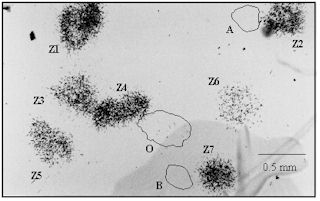
Figure 3B: Photomicrograph of Uranium fission-track print of mineral grain mount on mica external detector. Note that all of the zircons are revealed by a concentration of fission tracks that mirror the shape of the host grain. Note also that variation in density of fission tracks reflects variation in uranium content. Variation in track density within some grains reflects uranium zoning.
The other transparent minerals labelled A and B in Figure 3A have no fission track print and therefore contain no uranium, while the opaque mineral (O) has a very low density print reflecting a very low uranium content. Quantitative analysis of the area density of tracks in each grain print allows the absolute uranium content in each grain to be determined.
Uranium in zircons as a provenance indicator
The uranium content of detrital zircons can be used as a provenance indicator. In general terms zircons from crystalline mantle and crustal rocks can be easily distinguished by their U-content as illustrated in Figure 4. Mantle derived zircons, including those from diamondiferous kimberlitic sources, typically contain less than 60 ppm U (median ~10 ppm), while those from crustal sources contain much more (median ~300 ppm). This observation is particularly useful in alluvial and soil surveys for diamonds where the more traditional diamond indicator minerals have been removed by weathering processes. It also provides a possible exploration strategy for possible high grade, low-U zircon deposits.
Figure 4: Uranium content in zircon grains from crustal and mantle sources. Zircons derived from mantle (including kimberlitic) rocks have significantly lower uranium than those from crustal igneous rocks. This observation forms the basis for the use of zircons as a mantle source indicator in diamond exploration. (Uranium in individual grains determined by the fission track external detector method - Geotrack unpublished data)
Geochronology - zircon fission track analysis - ZFTA™
Detailed discussion of ZFTA is beyond the scope of this short paper. However, it should be noted that it is possible to use similar fission track methods to those described above to determine the age of individual zircon grains (eg Fleischer et al. 1975) from an alluvial sample. The resulting fission track age is numerically very similar to a K-Ar age on the original crystalline rock. Thus it is possible to relate ZFTA ages back to particular provenance areas. As a word of caution, some zircons contain so much uranium (or are so old) that the fission track radiation damage is so severe that they cannot be etched without dissolving the entire grain. This is a part of the process of metamictization. In such cases, a particular provenance age may not be revealed even though it makes up a high proportion of the zircons present.
Conclusions
The fission track technique allows both the rapid identification of the minerals hosting uranium and the determination of the absolute U content in single mineral grains. Such knowledge permits the development of strategies for adjusting mineral processing procedures to separate desirable low-uranium mineral populations. The technique can also provide valuable provenance information for sand-sized detrital products and in the case of zircon, direct age dating of individual grains.
References
FLEISCHER R. L., PRICE P. B. & WALKER R. M. 1975. Nuclear Tracks in Solids. Principles and Applications. University of California Press.
LOVERING J. F. and KLEEMAN J. D. 1970. Fission track Uranium distribution studies on Apollo 11 Lunar samples. Proceedings Apollo 11 Lunar Conference, 1, 151-158. Cambridge, MIT Press.
Australian Institute of Geoscientists Bulletin No. 26 1999
